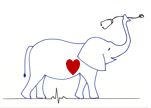Cardiac Drug Quiz
1. What is the primary site of action for torsemide?
a. Loop of Henle – thick ascending
b. Loop of Henle – thin descending
c. Proximal convoluted tubule
d. Distal convoluted tubule
Answer
2. Which of the following is NOT a recognized side effect of furosemide?
a. Dehydration
b. Electrolyte depletion (e.g., hyponatremia, hypochloremia, hypokalemia)
c. Azotemia
d. Pulmonary toxicity (e.g., Acute Respiratory Distress Syndrome)
Answer
3. When is the use of spironolactone possibly contraindicated?
a. In hypernatremic patients
b. In hyperkalemic patients
c. In patients with refractory congestive heart failure
d. When also prescribing furosemide
Answer
4. Which of the following statements about pimobendan use is CORRECT?
a. Pimobendan shortens survival time in dogs with myxomatous mitral valve disease if given before the onset of clinical signs
b. Pimobendan is a diuretic with beta-blocking properties
c. Pimobendan administration to cats with hypertrophic obstructive cardiomyopathy results in resolution of the outflow tract obstruction
d. Pimobendan has been demonstrated to improve outcomes for dogs in several veterinary clinical trials
Answer
5. Which of the following pairs is correct?
a. Venodilators: reduce preload
b. Arterial dilators: reduce cardiac output
c. Venodilators: increase blood volume returning to the heart
d. Arterial dilators: increase afterload
Answer
6. Sildenafil should not be used with which of the following drugs due to the possibility of life threatening hypotension?
a. Pimobendan
b. Hydralazine
c. Nitroglycerin
d. Lidocaine
Answer
7. Which species are reportedly especially prone to neurological side effects of Class I Antiarrhythmic drugs (e.g. lidocaine)?
a. Dogs and Cattle
b. Cats and Horses
c. Swine and Sheep
d. Llamas and Alpacas
Answer
8. Which of the following is not a common potential side effect of Class II Antiarrhythmic drugs (e.g. propranolol, atenolol, carvedilol)?
a. Bradycardia
b. Hypotension
c. Negative inotropism
d. Hepatotoxicity
Answer
9. What is the primary mechanism of action and result of the Class III Antiarrhythmic drugs (e.g. sotalol, amiodarone)?
a. Block potassium channels: prolong repolarization phase
b. Beta adrenergic receptor agonists: slow conduction through the heart
c. Block fast Na channels: slows generation of action potential
d. Calcium channel antagonists: vasodilation and increased heart rate
Answer
10. Which of the following descriptions correctly characterizes the cardiac glycosides (e.g. digoxin)?
a. Positive inotrope, positive chronotrope
b. Negative inotrope, negative chronotrope
c. Positive inotrope, negative chronotrope
d. Negative inotrope, positive chronotrope
Answer
11. Pimobendan might be recommended to treat:
a. Congestive heart failure
b. Pre-clinical degenerative mitral valve disease
c. Pulmonary hypertension
d. All of the above
Answer
12. One of the dose limiting side effects for the combined use of benazepril and furosemide is:
a. Azotemia
b. Increased serum bilirubin
c. Immunosuppression
d. Polyphagia
Answer
13. Sodium nitroprusside is usually used for animals with what condition?
a. Arterial thromboembolism
b. Pleural effusion
c. Severe pulmonary edema
d. Mild mitral valve regurgitation
Answer
14. Which drug is matched to the incorrect mechanism of action?
a. Spironolactone; aldosterone receptor antagonist
b. Pimobendan; Calcium channel blocker
c. Sildenafil; Phoshodiesterase 5 inhibitor
d. Lidocaine; Sodium channel blocker
Answer
15. Which of the following drugs is an example of a low molecular weight heparin?
a. Enoxaparin
b. Rivaroxaban
c. Clopidogrel
Answer
